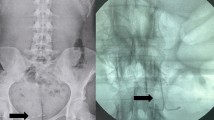Abstract
A new copper intrauterine device is described. Experience during 40 000 woman-months of use indicates that there have been no pregnancies and only 0.4 expulsions. At the end of 30 months of follow-up, 87.5% of the women are still wearing the device.
Resumé
Il est décrit un nouveau stérilet en cuivre. L'expérience sur 40.000 femmes-mois d'utilisation indique qu'il ne s'est pas produit de grossesses, et seulement 0,4 expulsions. Au bout de 30 mois d'observation, 87,5% des femmes portent toujours le stérilet.
Resumen
Se describe un nuevo dispositivo intrauterino con cobre. La experiencia durante 40.000 mujeres-meses de uso, indicó que no hubo embarazos y solamente 0,4 expulsiones. Al cabo de 30 meses de seguimiento, 87,5% de las mujeres continúan usando el dispositivo.
Similar content being viewed by others
References
Intrauterine devices. (1982).Population Reports, Series B,4, B105
HassonH. M., BergerG. S. and EdelmanD. A. (1976). Factors affecting IUCD performance.Am. J. Obstet. Gynecol.,126, 973
TatumH. J. (1972). Intrauterine contraception.Am. J. Obstet. Gynecol.,112, 1000–1023
MishellD. R.Jr. (1978). Historical considerations in the development of modern IUDs. Patient and device selection and the importance of the insertion technique.J. Reprod. Med.,20, 121–124
ShawS. T.Jr., ForinoR. V., PoonC. H. and MayerD. L. (1976). Influences of copper and design of intrauterine devices on endometrial bleeding in monkeys.Contraception,14, 9–15
KamalI., HefnawiF., GhonheimM., TaliatM. and AbdallaM. (1971). Dimensional and architectural disproportion between the intrauterine device and the uterine cavity. A cause of bleeding.Fertil. Steril.,22, 514–521
KurzK. H. (1981). Avoidance of the dimensional incompatibility as the main reason for side effects in intrauterine contraception.Contracept. Deliv. Syst.,2, 21–29
Author information
Authors and Affiliations
Additional information
Read at the 2nd Annual Meeting of the Society for Advances in Contraception, Jakarta, Indonesia, November 1984
Rights and permissions
About this article
Cite this article
Merchant, R.N. An IUD to fit any uterus. Adv Contracept 1, 151–156 (1985). https://doi.org/10.1007/BF01849795
Received:
Accepted:
Issue Date:
DOI: https://doi.org/10.1007/BF01849795




